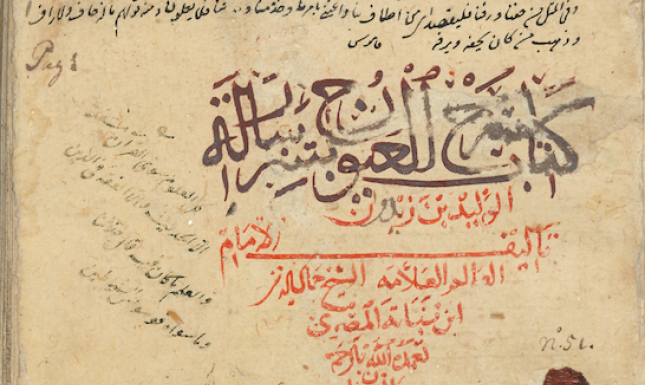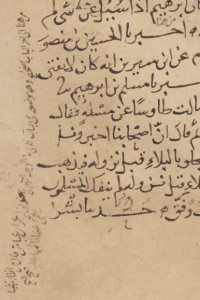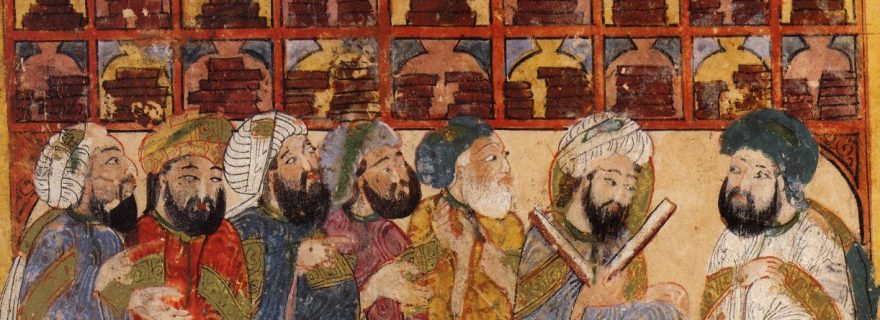Middle Eastern Manuscripts in the Digital World
Peter Webb discusses the shortcomings of studying printed editions of Arabic sources, and introduces a new Leiden initiative designed to help overcome the pitfalls: Mouse&Manuscript, a free online suite of lessons covering the essentials of how to read Middle Eastern manuscripts.
We have all heard the sound advice that we cannot judge a book by its cover. But what they don’t tell us is that sometimes we cannot even judge a book by its contents. This wrinkle puts a particular challenge to those wishing to deepen their understanding of Muslim culture and history.
Muslim societies from Timbuktu to Transoxiana were avowed bibliophiles, and writing books was a major and signature component of their cultural production. Before printing presses were established in the Middle East around the mid-nineteenth century, manuscript-makers had been copying books prodigiously since the early Middle Ages. Their legacy is millions of manuscripts now stored in libraries, museums, and family collections around the world. These manuscripts contain the outpouring of knowledge for which Muslim societies are justifiably proud, but since all manuscripts were copied by hand, and since erring is one of humanity’s core traits, any given manuscript is necessarily some parts knowledge, and other parts error. A reader needs to navigate the faults, some little and some big, to help interpret these books.


One of the greatest challenges to aspiring Arabic knowledge-seekers is the potential disconnect between the old manuscripts and the resources we now use to study classical Arabic culture and Islam. Today, manuscripts are seldom read: the old books have been reproduced in printed editions, many now digitised and readily Internet-searchable. However, these modern editions were quite often produced without careful consultation of the full range of the source manuscripts. An edition of an Arabic classic today therefore may or may not reflect the text preserved in its manuscripts, and those manuscripts in turn may or may not accurately reflect the original author’s intentions, either. When we quote authors from the past we are accordingly several steps removed from what they wrote, and our printed Arabic texts are thus prime examples of books which cannot be judged definitively by their contents.
Some disparities between original manuscripts and modern printings will not be radical, and some modern editors were very careful to produce good editions, but researchers who rely on nuances of text to develop interpretations about the past will benefit from visiting the old manuscript depositories. The future of studying Middle Eastern history leads through fresh enquiry into the sources, and teaching techniques to study the old books are required to guide students on their way.
Studying manuscripts also has the advantage of opening new windows into pre-modern Middle Eastern society and culture itself, since medieval Cairo, Baghdad, Samarkand, and elsewhere were worlds very much defined by their manuscripts. Urban literacy rates were high, books were as cherished as they were widespread, and manuscripts are amongst the most important tangible cultural property which these peoples left for us to appreciate.


Entering the books of the ‘Manuscript Age’ is a challenge, for we behold a very foreign space. Unlike printing presses, individual copyists had their own idiosyncrasies, and manuscripts also exhibit conventions now alien to modern readers. Perusing a manuscript, we will find unusual signs above and below words, intended to alert readers to matters of significance, and densely written notes sprawled across margins and titlepages convey other key indicators. Few of these signs, notes, and marks survived into printed books: they have become a code that now needs deciphering.
Until recently, learning how to decrypt copyist codes was complicated since manuscripts are scattered in special collections around the world where access is not always straightforward. But today, increasing numbers of manuscripts are available online, facilitating consultation without travel. Yet we still need a pathway to learn about how to read these old books, and herein a new Leiden University initiative offers help: Mouse&Manuscript. Our website constitutes the first ever free-access set of lessons about Middle Eastern manuscript culture based around important manuscripts of the Leiden collection, presented in a format that enables users from anywhere to effectively experience a first-hand reading of the books to the accompaniment of scholarly explanation.
The lessons cover papyrus fragments, Arabic literature, Coptic liturgy, pharmacological books, illustrated Persian epics, lavishly written books of prayer, and others. The lessons explain the quirks of how Arabic was written in the Manuscript Age, how books were made, read, how owners tried to protect them, and how some copies found their way into European libraries. The project is on-going and expanding: at present, there are twenty-eight lessons introducing the main topics a student needs to begin an academic foray into the world of Middle Eastern learning before the printing press. All lessons are freely available without signup or subscription, they can be completed in any order, and each lesson ends with questions (answers available at the click of a mouse) and assignments which invite users’ own analysis. The manuscripts await your visit at https://mouse.digitalscholarship.nl
Peter Webb is the content editor of Mouse&Manuscript. The project was initiated by Dorrit van Dalen, who engaged the Leiden Library and the Leiden University ExpertiseCentrum Online Leren (ECOLe) in designing the website. Dorrit, Peter, and seven other scholars have contributed the lessons.



0 Comments